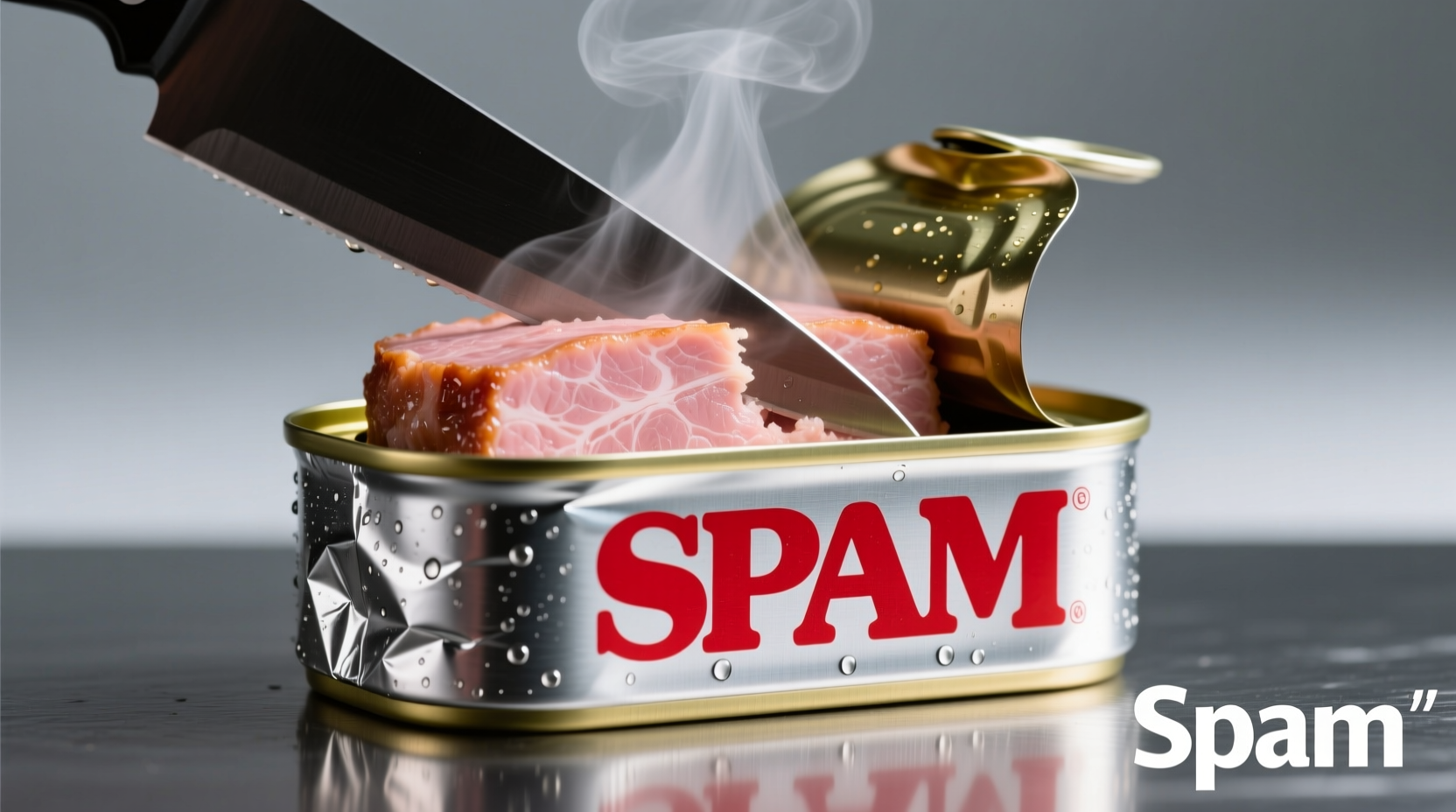Your Complete Guide to Understanding SPAM's Unique Flavor Profile
If you've ever wondered what does spam taste like when prepared correctly, you're not alone. This iconic canned meat product has sparked curiosity worldwide since its introduction during World War II. Understanding SPAM's distinctive flavor requires examining its composition, preparation methods, and how these factors influence the sensory experience.
Breaking Down SPAM's Core Flavor Components
SPAM's taste profile consists of three primary elements that work together to create its signature flavor. The salt content (approximately 2% by weight) provides the dominant initial sensation, followed by subtle smokiness from the cooking process, and finally the mild pork flavor that forms the foundation.
Unlike fresh pork products, SPAM's meat flavor is more subdued due to the canning process and added preservatives. The texture plays a crucial role in the overall experience—firm enough to hold its shape when sliced, yet tender with a slight springiness when bitten into. When fried properly, SPAM develops a delicious caramelized crust that enhances its savory qualities.
| Flavor Element | Intensity Level | How It Manifests |
|---|---|---|
| Saltiness | High | Immediate taste sensation, enhances other flavors |
| Smokiness | Medium | Subtle background note, varies by preparation method |
| Pork Flavor | Medium-Low | Milder than fresh pork, more pronounced when fried |
| Fat Content | Medium | Contributes to moist texture and rich mouthfeel |
How Preparation Methods Transform SPAM's Taste
Understanding what does spam taste like when fried versus other cooking methods is essential for appreciating its versatility. The preparation technique significantly impacts both flavor and texture:
- Frying: Creates a crispy exterior while maintaining a tender interior. The Maillard reaction enhances savory notes and develops complex flavor compounds.
- Grilling: Adds charred notes and reduces greasiness, making the pork flavor more pronounced.
- Boiling: Results in a milder flavor profile with less pronounced saltiness, preferred in some Asian preparations.
- Baking: Allows for flavor infusion with sauces or marinades while maintaining structural integrity.
Many home cooks wonder is spam salty or sweet—the answer depends on preparation. While SPAM itself has no added sugar, the caramelization during frying creates subtle sweet notes that balance the saltiness.

SPAM in Global Culinary Context
The question why does spam taste different than ham reveals important distinctions between these products. While both are pork-based, SPAM contains additional ingredients like potato starch and sodium nitrite that affect both preservation and flavor development. Unlike traditional ham, which undergoes lengthy curing processes, SPAM's flavor profile results from a combination of curing, cooking, and canning.
SPAM's cultural significance varies dramatically across regions. In Hawaii, where consumption per capita is highest in the United States, it's celebrated in dishes like SPAM musubi. In Korea, it's a beloved ingredient in budae jjigae (army stew). These cultural adaptations demonstrate how preparation methods transform what does spam taste like in different culinary contexts.
| Region | Popular Preparation | Flavor Transformation |
|---|---|---|
| Hawaii | Musubi (grilled with teriyaki) | Sweet-savory balance, reduced saltiness |
| Korea | Budae jjigae (stew with kimchi) | Spicy, fermented complexity |
| Philippines | Spamsilog (with garlic rice) | Garlic-infused, crispy texture |
| Mainland USA | Fried slices with eggs | Classic salty-smoky profile |
Practical Tips for Best Flavor Results
If you're exploring how to cook spam to enhance flavor, consider these professional techniques:
- Pat dry before cooking: Removes surface moisture for better browning
- Use moderate heat: Prevents burning while allowing proper caramelization
- Try different thicknesses: Thinner slices crisp completely; thicker slices maintain more tender interior
- Rest after cooking: Allows flavors to settle and texture to stabilize
Understanding spam texture description is crucial for optimal preparation. The ideal cooked SPAM should have a golden-brown crust with a tender, slightly springy interior—not rubbery or dry. When properly prepared, it should slice cleanly without crumbling.
Historical Context and Flavor Evolution
SPAM's flavor profile has remained remarkably consistent since its introduction in 1937, though minor formulation changes have occurred over time. The original product contained only six ingredients: pork with ham meat added, salt, water, potato starch, sugar, and sodium nitrite. This simple formulation contributes to its distinctive taste that has remained recognizable across generations.
| Time Period | Key Flavor Characteristics | Cultural Context |
|---|---|---|
| 1937-1945 | Higher salt content for preservation | Rationing during WWII made SPAM essential |
| 1945-1970 | Standardized flavor profile established | Became symbol of American food culture |
| 1970-Present | Minor adjustments for modern tastes | Global adoption with regional variations |
When SPAM Tastes Best: Contextual Considerations
Understanding the context boundaries for optimal SPAM consumption helps answer does spam taste like regular pork. SPAM shines in applications where its consistent texture and flavor profile are assets rather than limitations:
- When fried until crispy: The texture contrast enhances enjoyment
- Paired with strong flavors: Works well with eggs, kimchi, or teriyaki
- In cooked applications: Better suited for cooking than eating cold
- When properly stored: Freshness significantly impacts flavor quality
SPAM's flavor doesn't replicate fresh pork but offers its own unique culinary value. The key to appreciating what does spam taste like is understanding it as a distinct product with its own characteristics rather than comparing it directly to fresh meats.
Frequently Asked Questions
What does SPAM taste like compared to ham?
SPAM has a milder pork flavor than traditional ham with more pronounced saltiness. While ham develops complex flavors through lengthy curing, SPAM's flavor comes from the canning process and added preservatives. The texture is more uniform and less marbled than most hams.
Is SPAM supposed to taste salty?
Yes, saltiness is a defining characteristic of SPAM (approximately 2% salt by weight). This serves both preservation purposes and flavor enhancement. When properly cooked, the saltiness balances with other flavors, and pairing with less salty ingredients can create a more balanced dish.
How does cooking method affect SPAM's taste?
Cooking method significantly impacts SPAM's flavor profile. Frying creates a crispy, caramelized exterior that enhances savory notes. Boiling reduces saltiness but results in milder flavor. Grilling adds smoky notes, while baking allows for flavor infusion with sauces. Each method transforms what does spam taste like in distinct ways.
Why does SPAM taste different in different countries?
Regional variations in SPAM recipes and preparation methods create different taste experiences. Some countries use different spice blends or salt levels. Cultural preparation techniques—like Hawaii's teriyaki glaze or Korea's spicy stews—transform the base flavor profile to suit local palates, answering why what does spam taste like varies globally.
Does the expiration date affect SPAM's taste?
Yes, consuming SPAM within its recommended timeframe ensures optimal flavor. While properly canned SPAM remains safe well beyond the printed date, the flavor gradually changes as fats oxidize. Fresh SPAM has a cleaner pork flavor, while older product may develop slightly metallic or rancid notes, significantly altering what does spam taste like.











 浙公网安备
33010002000092号
浙公网安备
33010002000092号 浙B2-20120091-4
浙B2-20120091-4